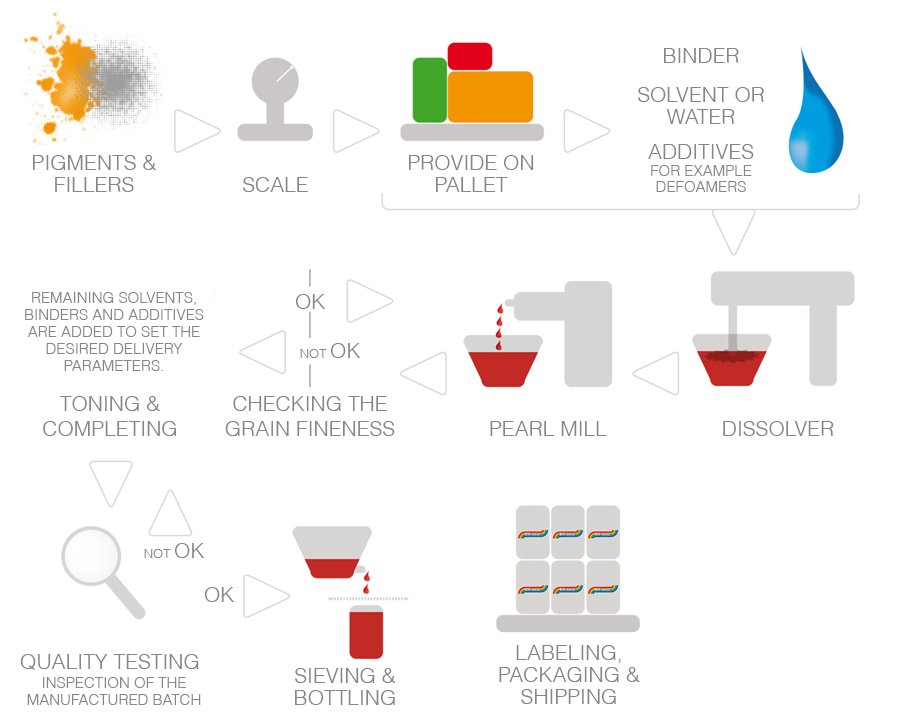Production process
In paint manufacturing, a precise process flow is established. The order of process steps is generally the same, although certain steps may be omitted depending on the type of coating material. For example, dispersion is not necessary in the production of clear coatings.
The process chain for colored topcoats can be most clearly illustrated. It starts with the provision of powdered raw materials (pigments, fillers) in the required quantity for the formulation. Liquid raw materials such as binders, water, and solvents are directly weighed into the production container. Pigments and fillers are then added to the liquid raw materials while mixing (formulation).
The resulting mill base is then subjected to dispersion. In the finishing step, the coating is precisely adjusted in terms of color and viscosity. The color measurement computer (spectrophotometer) measures the color tone and compares it with the customer's sample. If the deviation falls within the tolerance range, the coating is approved by quality control and filled into containers.
The formulation
The first step of the paint manufacturing process is called "Ansetzen" or "Vorlegen" in German. In this step, pigments and fillers are incorporated into a liquid phase. The following substances are filled into a clean container for this purpose:
- a portion of the binders
- a portion of the solvents
- necessary additives (auxiliary agents) such as defoamers, wetting agents, and dispersing agents
Next, the pigments and fillers are added to the pre-mixed binder solution and stirred until a homogeneous solution is obtained (this mixture is generally referred to as the grind). This step is followed by the first phase of dispersion, known as pre-dispersion. Pre-dispersion is carried out using a dissolver and is by far the most important step in the mixing process.
Dispersing - the grinding process
The second step of paint production is the dispersion process, which is often referred to as milling in the paint industry.
The dispersion process at SW color is carried out using agitator bead mills (pearl mills). These machines are closed systems, and their main advantage lies in emission control. The pearl mills consist of a closed grinding vessel that contains a rotating body, usually a shaft equipped with discs. The grinding vessel is filled with ceramic beads and is cooled.
Procedure: The pre-dispersed material (grinding stock) is pumped through the grinding vessel by a pump and circulates simultaneously around the agitator disc shaft. The dispersion occurs through friction, shear, and impact between the surfaces of the beads. Subsequently, the grinding stock is separated from the beads through a sieve. Once the required particle fineness for quality is achieved, the dispersion process is completed. The pearl mill is then cleaned.
Completion
The completion process is a particularly sensitive phase of paint production. Errors during completion can compromise the good dispersion results. Therefore, the correct sequence of adding the individual components must always be observed. Completing refers to the addition of the missing raw materials and semi-finished products (e.g., binders, additives, solvents, etc.) to the ground material according to the recipe.
Adjusting
The process step following the completion is called "Nuancieren" in German, which translates to "color matching" or "color adjustment" in English. It involves adjusting the exact color tone of a paint material. Color corrections are made using tinting pastes. To achieve the desired color tone, multiple color matching processes are often necessary. This step is carried out by specially trained personnel in the paint production industry who have extensive experience with tinting pastes and impeccable color vision. They are also responsible for adjusting important delivery parameters such as gloss level, conductivity, pH value, viscosity, and others.
Quality Testing & Approval
Quality control involves monitoring and measuring the product and the entire manufacturing process.
Each production batch is painted on various substrates (steel, aluminum, PVC, etc.) or on customer sample parts and dried according to customer specifications. After drying, the sample is compared to the color reference using a color measurement computer and visually inspected.
If there are any deviations, the product is adjusted until it meets the specifications. Once the optimal delivery parameters (gloss, adhesion, viscosity, etc.) are achieved, the paint is approved for release.
Upon customer request, we are happy to provide a test certificate for the delivered product.
Filling & Shipping
Filling means the precise introduction of the weighed amount of paint through a sieve into the containers requested by the customer. Special cleanliness must be observed during the filling process, particularly with regard to clean sieves and clean containers. Subsequently, the containers are labeled, packaged, and shipped in the shipping department.


